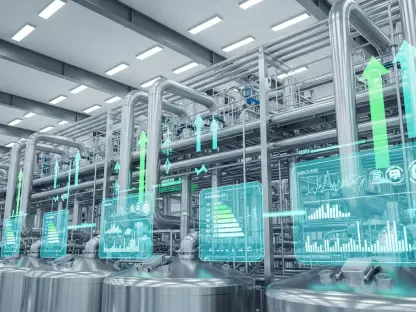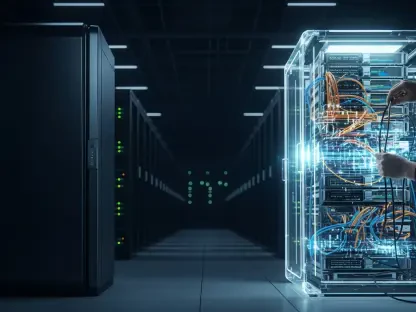The landscape of artificial intelligence (AI) is undergoing a profound transformation, driven by groundbreaking advancements in computing hardware that are pushing the boundaries of what’s possible. As AI models grow increasingly complex, their demand for computational power, energy efficiency, and rapid processing has revealed the shortcomings of traditional processors like CPUs and GPUs. This urgent need for innovation has led to the development of specialized AI chips and High Bandwidth Memory (HBM), technologies that are not just enhancing performance but fundamentally reshaping the future of computing. These advancements are central to what experts refer to as the “AI supercycle,” a structural shift in the semiconductor industry with the potential to revolutionize applications across various sectors. From powering self-driving cars to enabling smart home devices, the impact of this hardware evolution is already evident in everyday life. But what fuels this transformation, and how do these technologies meet the unique demands of modern AI? This exploration dives into the technical marvels of specialized chips, the critical role of HBM, the sweeping changes in industry dynamics, and the broader implications for society. Along the way, the challenges accompanying such rapid progress will be examined, as well as the future possibilities on the horizon. Prepare to discover how these innovations are laying the foundation for a new era of intelligent systems.
Breaking Away from Traditional Processors
The driving force behind the current hardware revolution in AI is the clear inadequacy of conventional processors to meet the escalating demands of modern workloads. General-purpose CPUs and GPUs, once the backbone of computing, now struggle with bottlenecks like the “memory wall,” where processing speed far exceeds the ability to access data from memory. Specialized AI chips, such as Application-Specific Integrated Circuits (ASICs), have emerged as a tailored solution, designed specifically for AI tasks like training massive models or running inference on new data. These chips offer remarkable efficiency, consuming less power while delivering higher performance compared to their general-purpose counterparts. This targeted approach allows for optimized handling of the parallel computations that dominate AI processes, addressing a critical gap in traditional architectures.
Another aspect of this shift is the diversity of specialized hardware architectures being developed to tackle distinct challenges. Neuromorphic chips, for instance, draw inspiration from the human brain, integrating memory and processing to eliminate traditional bottlenecks and significantly reduce energy consumption. Meanwhile, Field-Programmable Gate Arrays (FPGAs) offer adaptability, allowing reconfiguration for various AI applications, particularly in edge environments where low latency and minimal power usage are essential. This range of solutions reflects a strategic pivot in the industry, acknowledging that no single type of hardware can meet the multifaceted needs of AI. Instead, a variety of specialized tools is being crafted to ensure performance aligns with the specific demands of each use case.
Unlocking Performance with High Bandwidth Memory
High Bandwidth Memory (HBM) stands as a cornerstone of the specialized AI hardware ecosystem, addressing one of the most persistent challenges in computing: memory access speed. By utilizing a vertically stacked architecture of DRAM dies, HBM provides significantly higher bandwidth and lower latency compared to traditional memory solutions. This innovation ensures that the powerful processing capabilities of specialized AI chips are not hindered by slow data retrieval, allowing them to operate at full potential. As AI workloads become increasingly data-intensive, from training complex neural networks in the cloud to enabling real-time decisions in autonomous systems, HBM has become indispensable. Its ability to keep pace with the computational demands of modern models is a key driver of the AI supercycle.
Beyond its technical contributions, HBM is also reshaping market dynamics with its surging demand. With the market for this memory solution reaching unprecedented heights, supply chain pressures are becoming evident, as major players like Samsung and Micron struggle to meet industry needs. Shortages have led to rising costs and potential delays for smaller companies, underscoring the critical importance of scaling production to match the explosive growth of AI applications. The ripple effects of HBM’s prominence extend across the tech sector, as its integration into hardware designs becomes a competitive differentiator for companies aiming to deliver cutting-edge AI solutions. As a linchpin of performance, HBM is not just a supporting technology but a driving force in the broader transformation of computing infrastructure.
Reshaping the Tech Industry Landscape
The advent of specialized AI chips and HBM is sending shockwaves through the technology industry, fundamentally altering competitive dynamics and strategic priorities. Hyperscale cloud providers, such as Google and Amazon, are at the forefront of this shift, investing heavily in custom ASICs to optimize their AI services. By developing proprietary hardware, these giants can enhance performance for specific workloads, reduce operational costs, and decrease reliance on external chip vendors. This move not only boosts their ability to deliver scalable AI solutions but also positions them as leaders in a market where efficiency and speed are paramount. The push toward custom silicon represents a broader trend of vertical integration, where control over both software and hardware becomes a key competitive advantage.
Meanwhile, traditional semiconductor powerhouses are adapting to this new reality with varying strategies. NVIDIA, long dominant in the GPU space for AI training, faces growing competition from Intel, which is exploring neuromorphic computing, and AMD, which is expanding its portfolio of specialized accelerators. At the same time, a wave of innovative startups is entering the field, introducing disruptive concepts like photonic computing that challenge conventional design paradigms. This fragmentation of the market suggests a future where no single entity holds all the cards, but rather a diverse ecosystem of players contributes to a richer, more specialized landscape. The intense rivalry and innovation spurred by these technologies are redefining industry boundaries, with implications for everything from product development timelines to global supply chains.
Broadening the Horizons of AI Applications
One of the most transformative outcomes of specialized AI hardware is its ability to extend the reach of intelligence far beyond data centers. By enhancing computational efficiency, these chips make it feasible to deploy sophisticated AI models on edge devices, where power and space are often limited. Autonomous vehicles, for example, can now process vast amounts of sensor data in real time to make split-second navigation decisions, improving safety and reliability. Similarly, IoT devices in smart homes can learn user preferences directly on the device, reducing reliance on cloud connectivity and enhancing both privacy and responsiveness. This decentralization of AI capabilities is unlocking a new wave of applications that were once limited to high-powered, centralized systems.
The societal implications of this expanded access to AI are profound, impacting sectors as varied as healthcare, manufacturing, and consumer electronics. Portable medical devices equipped with specialized chips can deliver personalized diagnostics at the point of care, transforming patient outcomes in remote or underserved areas. Robotics in industrial settings benefit from low-latency processing to perform complex tasks with greater precision, boosting productivity. Even everyday gadgets like smartphones are beginning to integrate AI accelerators, enabling features like on-device language translation or image recognition without draining battery life. As these technologies permeate daily life, they promise to make AI not just a tool for tech giants but a ubiquitous force that enhances human capability across diverse contexts.
Navigating the Roadblocks Ahead
Despite the immense promise of specialized AI chips and HBM, significant challenges loom on the path to widespread adoption. Supply chain vulnerabilities, particularly around HBM, are a pressing concern, as demand far outstrips production capacity. These shortages create bottlenecks that can delay critical projects, especially for smaller firms lacking the resources to secure priority access to components. Rising costs associated with these constraints further complicate the issue, potentially slowing the pace of innovation in AI applications. Addressing these supply challenges will require coordinated efforts across the industry, from increasing manufacturing capacity to fostering strategic partnerships that ensure a stable flow of essential technologies.
Another hurdle lies in the environmental footprint of producing advanced semiconductors. While specialized chips often boast greater energy efficiency during operation, their fabrication processes are resource-intensive, raising concerns about sustainability in an era of heightened climate awareness. Additionally, the diversity of hardware architectures poses a software compatibility challenge, as developers must create frameworks that can seamlessly optimize AI models across disparate platforms. Overcoming this fragmentation demands industry-wide collaboration to establish standards and tools that bridge the gap between hardware innovation and practical deployment. Balancing the drive for progress with these operational and ecological responsibilities will be crucial to ensuring that the benefits of this technological shift are realized without unintended consequences.
Envisioning a Collaborative Computing Era
Looking to the future, the evolution of AI hardware points toward even deeper specialization, with chips designed for niche tasks such as vision processing or natural language understanding. Advances in HBM and innovative packaging methods are expected to further push performance boundaries, enabling more powerful and efficient systems. Consumer electronics stand to gain immensely, with “AI PCs” and smartphones integrating these technologies to bring advanced intelligence directly into users’ hands. This trend suggests a world where AI is not just a backend service but an embedded feature of everyday tools, reshaping how individuals interact with technology on a fundamental level. The potential for such integration to drive personalized, responsive experiences is vast and exciting.
Yet, realizing this vision will not be without its trials. The high costs of manufacturing cutting-edge chips, coupled with ongoing supply chain uncertainties, pose significant barriers to scaling these innovations. Moreover, the need for robust software ecosystems to support a heterogeneous mix of hardware remains a complex puzzle. A future where specialized and general-purpose processors collaborate—each handling workloads best suited to their strengths—offers a compelling blueprint for efficiency. Achieving this balance will test the industry’s ability to innovate not just in hardware but in the frameworks and partnerships that enable seamless integration. As these challenges are addressed, the groundwork is being laid for a computing era that prioritizes adaptability, efficiency, and accessibility, promising to redefine the role of AI in society.









